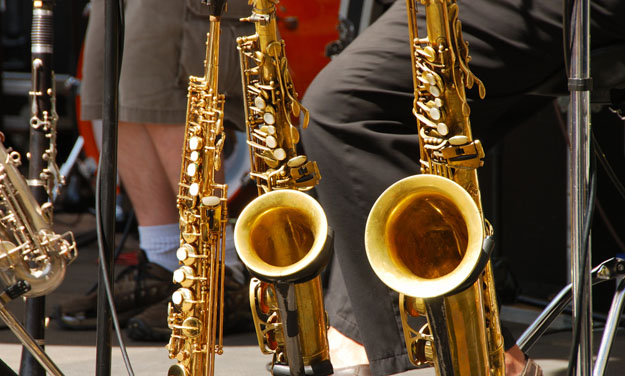How To Become A Pit Orchestra Musician
My path to becoming a pit orchestra musician started as a teenager. I was a mediocre guitarist with aspirations of being a rockstar. My high school was putting on a production of Once On This Island, and the choir/musical director needed a bassist for the show. She asked if I would be willing to learn and play bass instead of auditioning as a cast member (maybe she was onto something). I accepted the gig and tried my best. Although this would be my first and last bass gig (for everyone’s benefit), it definitely planted some inspirational musical seeds. Fast-forward 15 years to my life now as a professional pit orchestra guitarist, it seems time to put pen to paper and list some of the things that would have been beneficial to know before entering the professional world.

Below is a brief list of skills, ideas, and attitudes that will aid musicians interested in working in a professional pit orchestra. The list is by no means comprehensive, and may contain information that seems obvious, uninteresting, or tedious. But if you are a musician who is serious about working in pit orchestras - the more you know, the better.
Doubling
Most musicians typically practice to become as good as they can be at one instrument. Learning an instrument and developing proficiency is extremely challenging. So challenging, that it should be understandable if we stick to and expect to perform on that one instrument, right? Well in a musical theater environment, that is rarely the case.

One glance into a professional orchestra pit will reveal dozens of instruments with only a handful of players. The majority of pit orchestra musicians will transition between 2-6 different instruments throughout the course of a show. Each player will have their primary instrument (Guitar, Saxophone, Keyboard etc.) but then up to 5 additional instruments that are typically in the same family. Each of these additional instruments is called a “Double”. Below are a few typical examples of pit orchestra instruments and the associated doubles.
- Electric/Acoustic/Classical Guitar, Banjo, Mandolin, Ukulele
- Alto/Soprano Saxophone, Flute, Piccolo, Clarinet
- Tenor/Baritone Saxophone, Bass Clarinet
- Keyboard, Guitar
- Violin/Viola
- Trumpet, Flugelhorn
- Trombone/Bass Trombone
- Electric/Upright Bass
There are plenty of variations to these combinations that depend on what each show needs. Typically, the doubled parts are not as difficult or prominent as the primary instrument in a show, but there are always exceptions. It is best to gain proficiency on each double that is associated with your primary instrument. Taking extra lessons, working through method books, and learning tunes on your doubles are all very good practices.
Consistency
A single musical can go through several styles and genres. You may start a number with a laid-back Jazz feel, then immediately dive into some Hard Rock before a classic kick line ends the tune. Even though a show has endless variation, one of the most important skills a pit musician can posses is being consistent. Can you pull off the same phrases for eight shows each week?

Can you switch from one instrument to the next without something going awry? Can you play in tune even if you are cold? Practicing all of these things until they become internalized is crucial for musicians as the cast and crew rely on the same music every night. Many shows now employ click tracks for the orchestra and packaged sound libraries for the keyboards to keep the tempo and sound more consistent. Unfortunately, first learning how to play with a click track is typically done on the job, but practicing with metronomes or drum machines can help you prepare.
Included in this realm of consistency is punctuality and reliability. Don’t be the person who is frequently late, or you will soon not have a gig to be late for.
Reading Music
This may seem a bit obvious, but it is still important enough to mention. Pit musicians must be able to read music - specifically 5-line standard notation. There is a skill to reading this music, as theater shows are often full of strange vamps, cut offs, and irregular phrases. Being able to hang with a groove or style isn’t very useful if you don’t know when to start and stop that groove. Wind, String, and Keyboard parts are typically pretty straight-forward. Because notation developed simultaneously with these instruments, there is a greater chance that a composer/orchestrator will be familiar with their notational style. However, this is not the case for guitar, bass, and percussion.

Guitar parts can be all over the map in terms of accuracy, readability, and style, but you must be able to interpret them in a way that makes sense. Some books are written exclusively in older slash-style rhythm changes, newer charts tend to be more specific. There are of course, combinations of both. What is never the case is tablature. If you want to work on reading music, check out music lessons in Beaverton. There are times when tablature would be more effective in getting the point across, but every musical theater guitar book is written in standard notation.
Bassists can expect to find similar combinations of slash-style and specific notation. Grooves may be written out in detail or with only a direction like “Moderate Rock Groove” or “Funk Feel”.
As percussion notation isn’t often taught to studying musicians, drummers and percussionists tend to have the trickiest notation to decipher. No matter what mayhem you may encounter on the page, just remember that you are not alone and countless other drummers/percussionists have to deal with sub-par charts.
Finding The Gig
So you’ve learned every instrument known to man, and can play each one with ease and confidence. You nail the music every time and can read anything that is put in front of you. Now how do you get the gig?

Landing a gig in a pit orchestra usually depends on knowing how the community surrounding that gig works. Theater communities are different from city to city and circle to circle. There are many different tiers and production styles of theater including Regional, Cruise Ships, Touring, Off-Broadway, Broadway etc. Within each of these are different levels of production status regarding Union affiliation, how long a show has been running etc.
For this section of the article, I will focus on localized musical theater. A great place to start is by attending a regional theater, community, or even high school production of a musical. Look in the program and see who the Musical Director and instrumentalists are. Many of these musicians perform at several venues on different tiers of performances. They are the ones doing the job you want to do, and it would be wise to strike up a conversation or ask a them couple questions. Do not confront them during the show or at intermission. Consider heading down after the Exit Music to ask a question or see if you could get in contact with them. A large majority of hiring in the theater community comes from knowing the people who can do the job. If nobody knows who you are, you will have a much more difficult time getting hired. Always be kind and courteous. You never know who may help you, or who you may end up working with.
Live auditions are rare for pit orchestra musicians. But it is still likely the person doing the hiring will want to hear your playing. It is good to have video clips/recordings ready to go that are relevant to the gig. Many productions will issue a call for musicians and request materials like video/audio reels and a resume. Should you find yourself in the rare opportunity to have a live audition, being totally prepared is key (obviously).
Be Easy To Work With
There are many stereotypes associated with musical theater. One of the most common and celebrated is: The Diva. Cast members can often get away with being demanding and over-the-top. Their roles may even require that they behave in this way, and audiences tend to respond to it. For those of us behind the scenes and under the stage, however, being a Diva is a bad thing. Pit orchestras tend to be cramped, dark, and loud. We are allotted a certain amount of space to do our job, and that is what we have to work with. In these environments, the one thing that can really turn a great gig sour is the attitude of our coworkers. Always be respectful to the other musicians, and be willing to help them out. Orchestra pits are too small to fit everyone’s ego. Words travel quickly, and your fellow musicians’ opinion of you is very important. There are only a few musicians in the world who are so good they can get away with being a jerk. And in my experience, the ones who are that good are some of the nicest and most grateful individuals. As Dwayne “The Rock” Johnson said in his acceptance speech at the MTV Movie & TV Awards “It’s nice to be important, It’s more important to be nice.”
Conclusion
There you have it - five ideas to help you get started on being a pit orchestra musician. Keep in mind that the industry is always changing. These concepts and the specifics I laid out may shift with time, but the basic ideas will remain the same.



